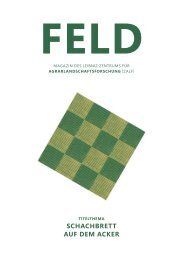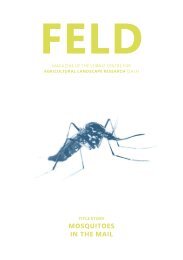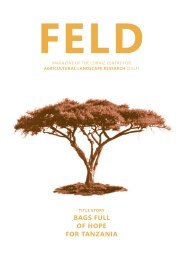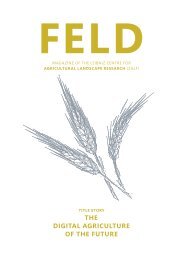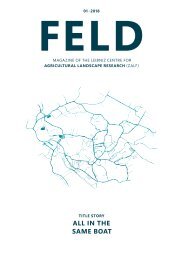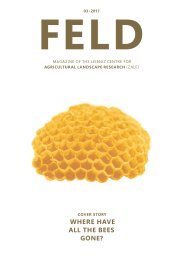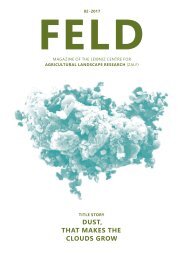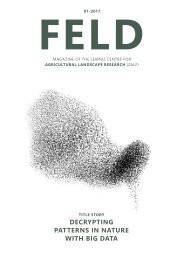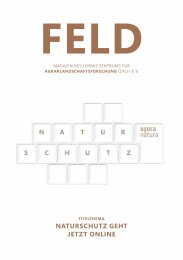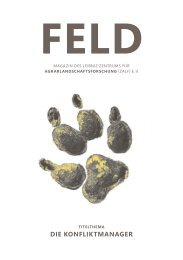FELD 01/2021
Launch of AgoraNatura: Private individuals and companies can now support environmental protection more easily thanks to the first online marketplace for nature conservation. // Does airborne dust spread antibiotic-resistant germs in our fields and thus endanger our health? Researcher Steffen Münch is looking for answers. // Farms need reliable forecasts of how climate change will affect their regions. A research team is investigating how well computer models are already performing this task. // Does organic farming protect the environment better than conventional agriculture? Karin Stein-Bachinger scientifically investigates this question and comes to clear conclusions.
Launch of AgoraNatura: Private individuals and companies can now support environmental protection more easily thanks to the first online marketplace for nature conservation. //
Does airborne dust spread antibiotic-resistant germs in our fields and thus endanger our
health? Researcher Steffen Münch is looking for answers. //
Farms need reliable forecasts of how climate change will affect their regions. A research team is investigating how well computer models are already performing this task. //
Does organic farming protect the environment better than conventional agriculture? Karin Stein-Bachinger scientifically investigates this question and comes to clear conclusions.
Create successful ePaper yourself
Turn your PDF publications into a flip-book with our unique Google optimized e-Paper software.
<strong>FELD</strong><br />
MAGAZINE OF THE LEIBNIZ CENTRE FOR<br />
AGRICULTURAL LANDSCAPE RESEARCH (ZALF)<br />
TITLE STORY<br />
NATURE CONSERVATION<br />
GOES ONLINE
Issue <strong>01</strong> · <strong>2021</strong><br />
SUSTAINABLE DEVELOPMENT GOALS<br />
CONTENTS<br />
17 »Sustainable Development Goals« are the centerpiece of the Agenda<br />
2030, approved in 2<strong>01</strong>5 by the United Nations (UN). The Agenda lays a<br />
foundation for global economic development in accordance with social<br />
justice and within the ecological boundaries of planet earth.<br />
MORE INFO<br />
https://sustainabledevelopment.un.org/sdgs<br />
Launch of AGORA NATURA: Private individuals<br />
and companies can now support environmental<br />
protection more easily thanks to the first online<br />
marketplace for nature conservation.<br />
02<br />
The research projects presented in this issue address the following<br />
Sustainable Development Goals:<br />
2 3 9 11<br />
ZERO HUNGER<br />
GOOD HEALTH AND<br />
WELL-BEING<br />
INDUSTRY, INNOVATION<br />
AND INFRASTRUCTURE<br />
13 14 15<br />
CLIMATE ACTION LIFE BELOW WATER LIFE ON LAND<br />
SUSTAINABLE CITIES<br />
AND COMMUNITIES<br />
Does AIRBORNE DUST spread ANTIBIOTIC-RESISTANT<br />
GERMS in our fields and thus endanger our<br />
health? Researcher Steffen Münch is looking<br />
for answers.<br />
FARMS need reliable forecasts of HOW CLIMATE<br />
CHANGE WILL AFFECT THEIR REGIONS. A research<br />
team is investigating how well computer models<br />
are already performing this task.<br />
DOES ORGANIC FARMING PROTECT THE ENVIRONMENT<br />
BETTER THAN CONVENTIONAL AGRICULTURE? Karin<br />
Stein -Bachinger scientifically investigates this<br />
question and comes to clear conclusions.<br />
10<br />
20<br />
32<br />
INTERVIEW 28 · QUER<strong>FELD</strong>EIN 38 · IMPRINT 40<br />
<strong>01</strong><br />
Subscribe to <strong>FELD</strong><br />
free of charge?<br />
Just send a mail to<br />
feld@zalf.de
TITLE STORY<br />
NATURE<br />
CONSERVATION<br />
GOES ONLINE<br />
9 13 15<br />
Most people think nature conservation is important and want to<br />
get involved. But only a few of them support projects financially.<br />
With »AgoraNatura«, a team of scientists, nature conservationists<br />
and farmers pursue a new approach to get more people<br />
interested in financially supporting nature conservation: Via the<br />
online marketplace www.agora-natura.de people can now invest<br />
in certified conservation projects. A newly created, scientifically<br />
tested nature conservation standard, regional projects with<br />
verifiable impacts and a great emphasis on transparency make<br />
it easier for private individuals and companies to contribute to<br />
environmental protection.
AgoraNatura<br />
AgoraNatura<br />
Lamb’s Succory doesn’t look like much: from June to September, it displays<br />
its small yellow flower heads, emerging from the ground on thin stems.<br />
Preferably on sunny waysides and in fields, Lamb’s Succory grows on sandy,<br />
nutrient-poor soils. It is this frugality that makes it harder for this species to<br />
survive nowadays: The use of fertilizers in agriculture is increasingly harming<br />
the delicate plant. Nationwide, the species is highly endangered and in some<br />
federal states it is even threatened with extinction.<br />
However, it can still be found in Matthias Prüfer’s fields in the Prignitz<br />
region. Prüfer carries out nature conservation measures to ensure that it stays<br />
that way. On one hectare of land, Prüfer now farms entirely without synthetic<br />
chemical pesticides and fertilizers, and with greater spacing between grain<br />
rows. In this environment, Lamb’s Succory can survive.<br />
By doing this, Mr. Prüfer is not only taking responsibility for an endangered<br />
plant species. He also protects the groundwater and promotes insects<br />
and other wild animal species. At the same time, his project site will generate<br />
less yield and income. However, the farmer is not left to deal with this situation<br />
alone but instead receives financial compensation. That is because his field<br />
is a pioneer project of the AgoraNatura research project. Supported by the<br />
German Federal Ministry of Education and Research, researchers are working<br />
with stakeholders from agriculture and nature conservation to develop<br />
For project leader Prof. Bettina<br />
Matzdorf (left) and Carolin Biedermann<br />
(right), AgoraNatura is also a<br />
means to study the financial commitments<br />
of citizens and companies to<br />
nature conservation.<br />
an online marketplace for certified nature conservation projects. Thanks<br />
to AgoraNatura, farmer Prüfer and the regional energy supplier WEMAG<br />
AG have joined forces. The company now finances the conservation area.<br />
»We harness the benefits of online marketplaces for nature conservation«,<br />
says project leader Prof. Bettina Matzdorf from the Leibniz Centre for Agricultural<br />
Landscape Research (ZALF), describing AgoraNatura’s main objective.<br />
In addition to ZALF, the University of Greifswald, the Environmental Action<br />
Germany (DUH) and the German Association for Landcare (DVL) are also<br />
involved. With just a few clicks, anyone can purchase shares of a nature conservation<br />
project of their choice and receive so-called nature conservation<br />
certificates in return. Each certificate is used to finance the implementation<br />
of the project on 100 square meters of land.<br />
THOSE WHO SEE RESULTS ARE MORE LIKELY TO INVEST<br />
The name tells the story: »Agora« is a Greek word and means »meeting place«.<br />
»This is where people come together, exchange ideas and have a say«, explains<br />
Matzdorf. On the one side are the providers of the nature conservation projects:<br />
people from agriculture and forestry, environmental organisations or<br />
landscape conservation associations who develop the measures. On the other<br />
side are the people and companies who want to get involved. Project manager<br />
Carolin Biedermann knows the »classic donor clientele«: people over 60 who<br />
donate over a long period of time and often to the same organisations. The<br />
problem, however, is that their numbers are declining and there is a lack of<br />
new donors, explains Biedermann. »Many people think nature conservation<br />
is important. But when they are asked for financial support, the majority is<br />
hesitant.« To find out why, the researchers asked citizens and companies about<br />
their attitudes towards nature conservation and a potential financial involvement.<br />
The results show that people especially get financially involved when a<br />
specific problem is identified, and they can see how and where their money is<br />
making an impact—a mechanism that is already well known from psychology<br />
as the »self-efficacy experience«. This is another reason why AgoraNatura<br />
focuses on regional projects with well-described objectives that are visible to<br />
local people: whether it is the species-rich orchard next door, the flowering<br />
area that attracts insects ten minutes away, or the extensive field with lots of<br />
wild herbs in the neighboring village. »Especially for companies that have an<br />
environmentally conscious clientele and workforce, regional commitment<br />
can mean added value«, emphasizes Matzdorf.<br />
04 05
AgoraNatura<br />
AgoraNatura<br />
NEW STANDARDS AND BETTER VISIBILITY<br />
The researchers also found that many people are unaware that an intact environment<br />
is made up of a variety of ecosystem services. Insect protection alone<br />
is often not enough. As in the case of Matthias Prüfer’s Lamb’s Succory project,<br />
AgoraNatura therefore provides detailed information: Do the measures<br />
on site result in more animal and plant diversity, cleaner water, or reduced<br />
greenhouse gas emissions? Almost always, several aspects of nature conservation<br />
are addressed at the same time, and everyone can support precisely<br />
those projects, whose goals seem particularly important to them.<br />
For greater transparency and security, the researchers developed a new<br />
standard for the certification of projects, each of which is assessed according<br />
to predefined criteria. The »NaturPlus« standard describes, among other<br />
things, how the projects are to be planned and how the set goals are to be<br />
verified. Only projects meeting this standard are offered on the AgoraNatura<br />
platform. »This transparently shows what happens to the money and which<br />
services are provided with it«, adds Biedermann.<br />
On AgoraNatura, interested parties can now support, for example, the<br />
Landcare Association Uckermark-Schorfheide. They plan to create a feeding<br />
area for the Lesser Spotted Eagle, the Red kite and the Black kite near Karlsberg.<br />
These birds are among those that are losing out against an intensified<br />
agriculture. They cannot find food on rapeseed or corn fields. Now, the land<br />
management is to be changed on an area of 16 hectares: Instead of cereals and<br />
oilseed rape, lucerne and legume-grass are to be grown as fodder. Mowing<br />
will only take place on parts of the field to promote mice and small mammals,<br />
which are the main food source for birds of prey. At the same time, the<br />
surrounding water bodies will benefit because the area is no longer fertilized.<br />
It’s examples like these, that are meant to expand and complement<br />
current nature conservation funding. »I can tackle nature conservation issues<br />
that are important to me close to my home and experience the impact of the<br />
projects«, explains Biedermann. This is because regular progress reports for<br />
all projects are provided on AgoraNatura.<br />
After five years of research, the AgoraNatura marketplace is now<br />
going online. »Research and implementation have worked hand in hand«,<br />
says Carolin Biedermann. This linkage, she says, has been a great opportunity<br />
but at the same time also a challenge. Many different stakeholders with<br />
many different experiences and needs had to be reconciled, and the research<br />
results had to be processed and translated so that they could be incorporated<br />
into the marketplace.<br />
Targeted donations from committed citizens or environmentally aware<br />
companies can support projects like this one in the Ferbitzer Bruch<br />
near Fahrland in Brandenburg.<br />
We harness the benefits of<br />
online marketplaces for nature<br />
conservation.<br />
PROF. BETTINA MATZDORF<br />
06 07
AgoraNatura<br />
AgoraNatura<br />
With its launch, though, the research is far from being completed. Beyond the<br />
questionnaires and statements of intent, researchers can now observe what is<br />
actually happening. »There is little sound data on the financial commitments<br />
of citizens and companies—especially in the context of nature conservation«,<br />
explains Biedermann. Using the data from the online marketplace, the research<br />
Five pilot projects were already financed before the official launch of the<br />
online marketplace. These include Farmer Prüfer’s Lamb’s Succory field.<br />
Annual monitoring of the area shows that the project is successful: the plant<br />
is growing and spreading. However, not only Lamb’s Succory benefits from the<br />
less intens ive agriculture. Other common plant species of agricultural fields<br />
as well as breeding birds have established on the site. »Nature conservation<br />
should also benefit from the boom in online marketplaces«, says Biedermann,<br />
looking to the future.<br />
Text: Heike Kampe<br />
Farming without synthetic chemical pesticides and fertilizers protects<br />
not only plant species, but also groundwater, insects and other wildlife.<br />
team will generate further knowledge about what makes projects particularly<br />
attractive, how providers and investors communicate with each other, when<br />
the willingness to support increases, and what might be the obstacles. Conversely,<br />
the data can reveal which conservation goals are unlikely to attract<br />
private donors so that funding through governmental instruments is of particular<br />
importance. The problem of soil erosion, for example, could be more<br />
difficult to convey than the protection of birds of prey.<br />
08 09
GONE WITH<br />
THE WIND<br />
3 11 15<br />
Wind creates change, moves waves and clouds, and shapes entire<br />
landscapes. We are happy about a fresh sea breeze blowing on<br />
a hot day at the beach and children flying their kites. Wind can<br />
transport many things, from the tiniest speck of dust to a glider—and<br />
sometimes also »stowaways«. These include, for example,<br />
bacteria found in fertilizer and stirred up by tillage. A research<br />
team has now taken a closer look at the spread of antibioticresistant<br />
germs in agriculture.<br />
10 11
Soil erosion<br />
Soil erosion<br />
The first antibiotic came onto the market in 1942. Penicillin was considered<br />
a miracle cure for bacterial infections. Less than 100 years later, antibioticresistant<br />
germs are now a great cause for concern. Due to the excessive use of<br />
antibiotics in humans and animals, some bacteria became resistant to antibiotics.<br />
Their effectiveness continues to decline and more people are dying<br />
from infections with these germs. Researchers are therefore looking for new<br />
drugs to combat them. At the same time, we need to better understand how<br />
these bacteria spread.<br />
Antibiotics are used in animal husbandry to prevent outbreaks of disease<br />
as production increases to meet the growing global demand for meat.<br />
When humans consume products from animals treated with antibiotics,<br />
they also ingest their residues. Researchers at the Leibniz Centre for Agricultural<br />
Landscape Research (ZALF) are interested in the extent to which we<br />
also come into contact with antibiotic-resistant germs through the manure<br />
used as agricultural fertilizer.<br />
The meteorologist Steffen Münch has taken up this topic. He has<br />
been conducting research at ZALF for more than three years, currently in<br />
the »SOARiAL« project funded by the Leibniz Association. How did he get<br />
involved in agricultural landscape research? »In meteorology, the so-called<br />
atmospheric boundary layer is the crucial layer responsible for transporting<br />
the smallest particles and bacteria from the Earth’s surface into the atmosphere«,<br />
explains the scientist. »During my studies, I started to look at such<br />
particles, and these also primarily include those released from arable soils.«<br />
In the project, four Leibniz institutes and the Free University of Berlin are<br />
jointly investigating the spread of antibiotic-resistant germs in agricultural<br />
landscapes. The focus is on the wind-driven »atmospheric transport pathway«.<br />
CRITICAL PHASES IN FIELD WORK<br />
It is certain that antibiotic-resistant germs can survive in both the meat and<br />
the manure of the animals. The multiresistant pathogens were detected by<br />
the researchers for example in chicken coops. But the excrements of pigs,<br />
cows and other animals are also used as organic fertilizers in agriculture. The<br />
researchers see a variety of risks. »We identified four phases in which there<br />
is a risk of surviving bacteria being transported, for example, through the<br />
air into the environment«, Münch says. The first critical phase is the storage<br />
of the manure. How long can the antibiotic-resistant germs survive here?<br />
The spreading of the manure on the fields is another critical phase, because<br />
The drier the fertilizer that is<br />
spread on the field, the more<br />
fine dust is released.<br />
STEFFEN MÜNCH<br />
it creates a lot of dust, especially when the manure is well dried. Bacteria,<br />
in turn—and that means all of them, regardless of whether they are antibioticresistant<br />
or not—like to use these dust particles as carriers in order to be able<br />
to travel longer distances. Once the fertilizer has been spread onto the field,<br />
it must be incorporated into the soil. This procedure once again produces<br />
dust emissions, making it the third critical phase. If the field remains bare<br />
after fertilizer application because the plants do not grow immediately, wind<br />
erosion may occur, particularly on sandy soils. Medium to strong winds can<br />
remove and carry away the lightest soil particles—another critical phase.<br />
Particularly the field workers and the neighboring communities are<br />
exposed to the dust clouds during these work steps and thus to an increased<br />
risk of inhaling these tiny dust particles—and therefore possibly also the<br />
antibiotic-resistant germs.<br />
WHAT IF?<br />
Using computer simulations, the project team discovered that the dust generated<br />
during fertilizer application in Muencheberg, Brandenburg, could theoretically<br />
be transported as far as the Black Sea—more than 1.500 kilometers away.<br />
12 13
Soil erosion<br />
Soil erosion<br />
During field trials in Potsdam (top) and<br />
Müncheberg (left), the dust released during<br />
fertilizer application and incorporation was<br />
measured. In ZALF’s wind tunnel, Steffen<br />
Münch investigates the influence of fertilizer<br />
on wind erosion under controlled conditions<br />
(bottom).<br />
14 15
Soil erosion<br />
Soil erosion<br />
In the morning, the<br />
dust particles are not<br />
transported as far.<br />
STEFFEN MÜNCH<br />
contamination with antibiotic-resistant germs was neither detected in the<br />
manure stored for up to four weeks nor in the dust clouds. The soil into<br />
which the fertilizer was incorporated also remained free of contamination<br />
with multiresistant pathogens.<br />
»Bacteria like moisture—especially moist heat. It is thus advisable for<br />
fresh fertilizer to be dried first before it’s spread on the field«, Münch explains.<br />
Does this mean that there is an easy solution? The fertilizer just needs to be<br />
completely dried? Not quite: »The drier the fertilizer that is spread onto the<br />
field, the more fine dust is released. Fine dust is also harmful to health and,<br />
after all, the fertilizer should remain on the field rather than swirling through<br />
the air as fine dust. The ideal solution would therefore be to dry it with hot<br />
air and then remoisten it. But this is very cost-intensive and time-consuming<br />
and difficult to implement in practice«, Münch knows.<br />
In addition to the moisture content, the storage duration of the chicken<br />
manure is another crucial factor for the survival of antibiotic-resistant bacteria.<br />
»Our results show that antibiotic-resistant bacteria in manure are no<br />
longer viable after only three to five days of storage«, Münch says. In addition,<br />
his team also examined pig manure. After drying, its emission behavior<br />
resembles that of chicken manure. However, compared to chicken manure,<br />
pig manure typically has a higher moisture content and thus requires more<br />
drying to achieve the same reduction in pathogenic germs.<br />
»In our trials, we did not observe that antibiotic-resistant bacteria<br />
were transported through wind erosion. The soil fertilized with manure was<br />
also free of antibiotic-resistant bacteria«, Münch concludes.<br />
How far this dust can actually be transported depends on the time of day, along<br />
with other factors: »At night, a barrier layer is forming in the atmosphere.<br />
You can imagine this as a kind of lid that prevents air cirulcation. In the morning,<br />
this barrier layer is still active and the dust particles are not transported<br />
as far«, Münch explains. The morning hours are therefore the optimal time<br />
to apply and incorporate the fertilizers.<br />
Text: Julia Lidauer<br />
ALL-CLEAR<br />
After 36 months of research, the final results are now available. The scientists<br />
can give an all-clear for the investigated 9.3-hectare field site. It is true<br />
that antibiotic-resistant bacteria were still found in the chicken coop. But<br />
16 17
Wind erosion<br />
Wind erosion<br />
WIND EROSION<br />
Wind and field work using machines lead to dust emissions on our fields. Light<br />
soil components, such as clay and humus particles, are most easily lifted and<br />
carried away. But particularly these particles contain nutrients and are thus<br />
most valuable for soil fertility. This gradual decline in fertility has become one<br />
of the main causes of soil degradation in Europe. In addition, dust clouds can<br />
harm the health of humans and animals.<br />
Trees and hedges in the landscape provide wind protection<br />
The more and the denser trees and hedges grow<br />
along the edges of fields, the better they can protect<br />
against wind. Simple tree rows do not necessarily<br />
prevent high-speed winds directly above the ground.<br />
Tree rows lined with hedges<br />
are ideal.<br />
How far are the airborne soil particles transported?<br />
Sparse ground cover<br />
makes soils more prone<br />
to wind erosion.<br />
Bare ground<br />
is most vulnerable to<br />
wind erosion.<br />
Sand: Is only whirled up close to the ground and transported no<br />
farther than to the edge of the field or the next hedge, etc.<br />
Silt + humus particles: Are sometimes displaced over several kilometers<br />
from the dust source, where they also measurably reduce air quality.<br />
Clay + soil micro-organisms: Are transported high into the atmosphere,<br />
where they are sometimes dislocated over thousands of kilometers.<br />
Crop residues<br />
remaining on the field can<br />
provide some protection.<br />
Crops<br />
protect the soil once<br />
they reach a certain<br />
stage of growth.<br />
A combination of crops<br />
and crop residues<br />
provides fairly good protection.<br />
Well-vegetated<br />
topsoil<br />
provides the best<br />
protection.
CLIMATE CHANGE<br />
ON OUR DOORSTEP<br />
2 9 13<br />
We have a pretty good idea of how the climate on our planet will<br />
change on average over the next few decades. Yet terms such as<br />
»global warming« and »two-degree target« offer farmers few<br />
clues as to what they specifically should prepare for, because<br />
locally the effects will differ, sometimes considerably. In order to<br />
be able to prepare for the future, farms need reliable local forecasts.<br />
Computer models are to make this possible.<br />
20 21
Computer models<br />
Computer models<br />
On a global average, rising temperatures and droughts will be the most common cause of<br />
yield loss (left). However, there are also regions where farms have to prepare for excessive<br />
rainfall (right).<br />
»Our goal is to predict the future.« Dr. Heidi Webber knows how unrealistic<br />
this sounds at first. But the agricultural engineer remains resolute: »Agriculture<br />
has to adapt to climate change, that much is certain. But what exactly<br />
does that mean? What are the concrete effects in the Magdeburg Börde or in<br />
the Uckermark? Should farms here brace themselves to face heat and drought,<br />
or rather hail and heavy rain?« Finding reliable answers to this question is an<br />
important basis for ensuring that agriculture can continue to secure our food<br />
supply in the future. But this means adapting farming methods and crops to<br />
future conditions. New insurance policies and political programs are also<br />
needed to provide rapid assistance in the event of crop failures. All this will<br />
only work if we have reliable information about what agriculture will be facing<br />
in 10, 20 or even 50 years’ time. And until mankind invents a time machine,<br />
there is only one way of looking into the future: computer models.<br />
But how well do the numbers on the computer screens match the<br />
climate reality on the ground? This is the challenge researchers are facing<br />
around the world, including Heidi Webber. Their problem is that these models<br />
were originally designed to help assess climate change on a global scale. Now<br />
making reliable predictions of how the climate and crop yields will develop in<br />
individual regions turns out to be a much more difficult task. At the Leibniz<br />
Centre for Agricultural Landscape Research (ZALF), Dr. Webber and her<br />
team are therefore currently testing how well their computer models have<br />
been performing this task so far in the various regions of Germany.<br />
TWO QUESTIONS, TWO SOLUTIONS<br />
»Basically, we are facing two challenges: Do the models include all the important<br />
causes of yield variability, and can they also make predictions for a future<br />
in which the climatic conditions change?« says Webber. Two challenges that<br />
require different types of computer models.<br />
Her team colleague Prof. Gunnar Lischeid is an expert on so-called<br />
»data- driven models«. Put simply, these computer models at ZALF independently<br />
analyze which weather events were responsible for yield losses<br />
observed in recent years. »The difficulty is to construct the models correctly.<br />
22 23
Computer models<br />
Computer models<br />
When soils are waterlogged,<br />
heavy farm machinery can<br />
barely access fields for plowing<br />
and harvesting. In addition,<br />
wet soil compacts significantly<br />
more under the weight of the<br />
machinery, which also affects<br />
soil fertility in the long term.<br />
Our goal is to predict the future<br />
climate for each region as<br />
accurately as possible.<br />
Once that’s done, however, we get valid statements without having to make<br />
overly specific hypotheses beforehand that might mislead the model.« One<br />
advantage, according to Prof. Lischeid: »We have built up a good data base<br />
in Germany over the last 40 years: on the weather, on the soils and on agricultural<br />
yields.« Based on this wealth of data, the data-driven models initially<br />
reveal an underlying correlation: It is not so much particular extreme weather<br />
conditions that are crucial factors for causing severe yield losses. Rather, it’s<br />
the coincidence of unfavorable conditions at different stages of crop growth.<br />
»The negative effects of a winter that is too cold, for example, are not compensated<br />
for by a hot summer; instead, the effects reinforce each other«, says<br />
Lischeid. Looking at regional impacts in extreme weather years, Dr. Webber<br />
also discovered something fascinating in the results from the models: »While,<br />
as expected, heat and drought play a major role in large-scale yield losses,<br />
excessive precipitation is increasingly the problem in localized incidents.«<br />
For all their advantages, however, data-driven models also have limitations.<br />
They cannot think »outside the box« and can therefore only explain<br />
conditions that they find in the input data sets. »These models found it difficult<br />
to explain 2<strong>01</strong>8 well, as there simply has never before been such a combination<br />
of a wetter-than-average winter with a very hot and dry summer in Germany<br />
during the last 40 years«, Lischeid said. But how can we then look to the future,<br />
when many of the prevailing conditions will change?<br />
DR. HEIDI WEBBER<br />
LOOKING TO THE FUTURE<br />
For this, we need a second type of computer simulation, the »process-based models«.<br />
These modells simulate the physical and chemical processes that lead to plant<br />
growth, but also plant death. »If we digitally recreate the processes correctly, they<br />
will also react realistically in the model to new prevailing conditions, for example<br />
24 25
Computer models<br />
Computer models<br />
We have built up a good data<br />
base in Germany over the<br />
last 40 years.<br />
as disease in crop stands, more nitrate is leached, and there can be a lack of<br />
oxygen in the soils«, Webber explains. So, which of these processes are the<br />
most important and absolutely need to be simulated for future predictions?<br />
»That, in turn, is something the data-driven models can tell us«, says Lischeid.<br />
»The two types of models complement each other.« In the future, the team<br />
plans to further optimize the models by expanding the study to other Central<br />
European countries. Additionally, the type of field management will be taken<br />
into account.<br />
Many important decisions about the future of agriculture need to be<br />
made today. To do this, accurate predictions of the regional effects of climate<br />
change are needed as quickly as possible. The modeling experts at ZALF are<br />
optimistic, because their simulations are getting better and better.<br />
PROF. GUNNAR LISCHEID<br />
Text: Tom Baumeister<br />
more CO2 in the atmosphere. This allows for more valid statements about the<br />
future«, Webber says. In fact, the process-based models at ZALF were better<br />
at simulating the year 2<strong>01</strong>8. However, this is only because heat and drought<br />
reduced yields in that year, which the process-based models already represent<br />
very well. »We’ve also learned that we can’t yet simulate yield fluctuations<br />
caused by excessive precipitation well«, Webber explains. Simply incorporating<br />
these processes into the process-based models carries risks, Webber says:<br />
»Often, there is not enough data for new processes to be simulated. Therefore,<br />
as the models become more realistic, they not only become more complicated,<br />
but the uncertainty in the parameters used also increases. From a certain<br />
point onwards, the model results thus become more error-prone as opposed<br />
to improving.«<br />
THE MODELS COMPLEMENT EACH OTHER<br />
However, modeling rainfall damage quickly becomes very complex. »This<br />
includes everything from crops knocked down by hail to wet soils that can’t<br />
be driven on with machinery. A lot of moisture also promotes fungi as well<br />
THE RESEARCHERS<br />
Dr. Heidi Webber heads the »Integrated Crop<br />
System Analysis and Modelling« working<br />
group at ZALF.<br />
Prof. Gunnar Lischeid is co-head of the »Data<br />
Analysis & Simulation« research platform.<br />
26 27
Interview<br />
REGIONAL OR GLOBAL<br />
SUPPLY SYSTEMS?<br />
Will the corona pandemic<br />
change agriculture?<br />
Dr. Piorr, Prof. Ewert, we remember the<br />
panic buying at the beginning of the corona<br />
crisis in 2020. Even though food supply in<br />
Germany has been ensured without restrictions,<br />
criticism against global supply chains<br />
is growing. Can more regional approaches<br />
make our agriculture more sustainable, more<br />
climate-adapted and also more resilient?<br />
Prof. Ewert: Overall, this is a comparatively new<br />
research field. In order to evaluate food supply<br />
in terms of sustainability, you have to look very<br />
closely at supply chains and their impact on the<br />
entire food supply system. If we shorten supply<br />
chains, i. e. rely more on regionally produced<br />
products, we can save transport costs, resources<br />
and CO2 emissions. But if we now would have<br />
to operate greenhouses as a result, which we<br />
would not need to do in southern regions, the<br />
avoided transport costs could be outweighed<br />
by the increased energy consumption, and the<br />
regional advantage would no longer exist. This<br />
example alone shows that it is always very important<br />
to look at the entire complex system for<br />
an evaluation.<br />
Dr. Piorr: Our experience, also from our international<br />
projects, shows that in the medium<br />
term a good balance between regional and global<br />
value chains will be important. In effect, this<br />
means developing regional systems in such a way<br />
that their advantages over the overall global system<br />
can be utilized. For example, they are more<br />
adaptable to local conditions. Moreover, and this<br />
is something we shouldn’t forget in the current<br />
pandemic: Climate change has to be considered<br />
at all times.<br />
Prof. Ewert: I agree and I would like to add<br />
one more point. If we think about regional systems—the<br />
fact that they are decoupled from the<br />
international market doesn’t necessarily mean<br />
they are necessarily more resilient to crises. Just<br />
think about the droughts of 2<strong>01</strong>8 and 2<strong>01</strong>9,<br />
during which an exclusively regional market<br />
would have led to enormous food supply problems.<br />
When we apply this to the challenges of the<br />
corona pandemic, we see the benefits of having<br />
a system that stands on two feet, so to say.<br />
The corona pandemic will change various<br />
areas of our lives forever. What development<br />
do you see, for example, in the case of further<br />
waves of infection and beyond?<br />
Prof. Ewert: If the situation gets worse, we can<br />
assume that, in the short term, politics in particular<br />
will focus on securing the food supply.<br />
We all remember the flights that brought workers<br />
from Eastern Europe to Germany despite the<br />
closed borders. Businesses upstream and downstream<br />
of agriculture would certainly be most<br />
affected, such as the processing and distribution<br />
of food. Agricultural production itself is less<br />
at risk, with an average self-sufficiency rate of<br />
around 80–90 percent in Germany, depending<br />
on the product group. The empty shelves had<br />
more to do with consumer behavior. As far as<br />
our research is concerned, the goal is clear, and<br />
it has not changed as a result of the pandemic:<br />
We need more resilient, sustainable agricultural<br />
systems in general. In other words, systems<br />
that, in addition to providing food and other<br />
ecosystem services, such as clean water or clean<br />
air, are also more robust in their response to<br />
climatic changes and extreme weather events.<br />
Biodiversity is also increasingly entering public<br />
awareness. What’s more: an often neglected service<br />
our agricultural landscapes are providing<br />
became much more apparent now because of<br />
the international travel restrictions: Rural areas<br />
are destinations for regional tourism and the<br />
demand for local recreation areas is increasing.<br />
Dr. Piorr: We are also following developments<br />
on a worldwide scale that give us a good impression<br />
of the challenges ahead of us: In Qatar,<br />
the food supply completely collapsed after just<br />
a few days as the result of a food embargo. In<br />
response they now construct greenhouses on<br />
a large scale requiring enormous amounts of<br />
water and energy. But Qatar also bought vast<br />
areas of land in Africa or made supply contracts<br />
with Canada for animal feed. The aim is also to<br />
28<br />
29
Interview<br />
Interview<br />
produce food locally to secure their own supply.<br />
Of course, this strategy also bears enormous<br />
potential for international conflict. What is<br />
needed, therefore, is a system balanced between<br />
regionality and globality, specifically adapted<br />
to each region. A system in which social, economic<br />
and ecological factors and resilience<br />
considerations are addressed alike. But what we<br />
can learn from Qatar is to consider for which<br />
food products we want to set more incentives<br />
for local production to prevent supply crises.<br />
Prof. Ewert: Also, conclusions drawn from the<br />
current crisis should not solely address the security<br />
of food supply. Especially because it is so far<br />
not foreseeable that incidents similar in extent to<br />
the corona pandemic will soon be reoccurring.<br />
Most recently, the societal debate was dominated<br />
by questions on how to deal with climate change<br />
and the declining numbers of insect species. These<br />
challenges have not disappeared. More resilient<br />
agricultural systems target all of these challenges.<br />
We have now looked at agricultural production<br />
and the agricultural landscape. Which<br />
trends are currently foreseeable in the food<br />
sector? What role do consumers play here?<br />
Prof. Ewert: If the situation worsens again,<br />
we can expect further political and social discussions.<br />
This will particularly affect food products,<br />
such as fresh vegetables, which are currently imported<br />
from other European countries at a high<br />
cost in terms of resources. I also still remember<br />
the general surprise when many consumers actually<br />
put the continual recommendation of a<br />
federal authority into practice, to have supplies at<br />
home for a few days, resulting in empty shelves<br />
for some products. What I would like to point<br />
out here is that the relationship between the<br />
system as a whole and the actions of individuals<br />
is, in some cases, closely interconnected. In addition<br />
to »panic buying« on the one side of the<br />
extreme, we have also seen a large number of<br />
positive examples during the crisis, such as the<br />
increased use of our own gardens, the growing of<br />
vegetables on balconies, or more interest in concepts<br />
such as urban agriculture or the principles<br />
of community supported agriculture. During the<br />
crisis many people have started to ask more and<br />
more where our food actually comes from—this<br />
is very positive.<br />
Dr. Piorr: Further research has to show now to<br />
what extent these cooperative structures and the<br />
exchange of knowledge on this issue in general<br />
can strengthen the robustness and resilience of<br />
the broader food system. As a result of the crisis,<br />
the exchange of experience and models of good<br />
practice, for example in food councils, is increasing.<br />
Hopefully, this will be something to remain.<br />
Empowerment and structures such as community<br />
supported agriculture are getting producers<br />
and consumers closer together again.<br />
The interview was conducted by Hendrik Schneider.<br />
DR. ANNETTE PIORR<br />
heads the working group »Land Use Decisions<br />
in the Spatial and System Context« at ZALF.<br />
PROF. FRANK A. EWERT<br />
is the Scientific Director of the Leibniz Centre for<br />
Agricultural Landscape Research (ZALF).<br />
30<br />
31
THE BIG<br />
DIFFERENCE<br />
13 14 15<br />
In order to provide food security for billions of people, farming is<br />
becoming increasingly intensive—with negative conse quences for<br />
the environment and biodiversity. Conventional farming stands in<br />
contrast to organic farming, which follows stricter rules. Mineral<br />
nitrogen fertilizers and synthetic pesticides, for example, are prohibited<br />
here. A study investigated the impact of both concepts<br />
on the environment—with clear results.<br />
32 33
Organic farming<br />
Organic farming<br />
When it comes to organic farming, Dr. Karin Stein-Bachinger has a clear<br />
opinion: It could be the key to solving many pressing environmental problems—and<br />
must be expanded. This opinion is based on scientific facts, because<br />
the agricultural scientist from the Leibniz Centre for Agricultural Landscape<br />
Research (ZALF) has been conducting research in this field for already 30 years.<br />
In an extensive study, Karin Stein-Bachinger and her team recently<br />
evaluated 98 scientific studies comparing conventional and organic farms with<br />
a focus on biodiversity, the loss of which is one of the greatest threats to our<br />
ecosystems. The results are clear: The diversity of wild plants was on average<br />
95 percent higher on organically farmed sites than on conventionally farmed<br />
ones. The researchers also found 35 percent more bird species and 22 percent<br />
more insect species in the organic fields. Organic farming also scores well in<br />
terms of animal abundance: Overall, 24 percent more birds, 36 percent more<br />
insects and 55 percent more spiders find a home where farming is organic.<br />
MANY WILD PLANTS DON’T STAND A CHANCE<br />
Karin Stein-Bachinger is not surprised by these results. »It has been known<br />
for a long time that the biodiversity on organically farmed land is significantly<br />
higher«, she says. »However, there is no comparable recent study that also<br />
evaluates this quantitatively in such detail«, she emphasizes. In particular,<br />
the widespread use of herbicides and fertilization practices on conventional<br />
farms are causing the number of species of wild plants to decline. Many<br />
non-competitive wild plants such as Forking Larkspur, Scarlet Pimpernel<br />
and Field Madder do not stand a chance in the densely covered, intensively<br />
cultivated fields. »Many areas are extremely impoverished in terms of diversity«,<br />
says the researcher—and this is not only evident directly on the field,<br />
but also in adjacent areas: Around one-fifth more plant species are sprouting<br />
on the field margins of organic farms than in comparative areas under conventional<br />
management.<br />
This has direct consequences for wildlife. Where there is a wide variety<br />
of flora, specialized species also find good habitats—such as wild bees,<br />
which are particularly efficient pollinators. This diversity of plant species on<br />
farmed land is one factor, but not the only one, explains Karin Stein-Bachinger:<br />
»Landscape elements such as hedges, field margins, and piles of stones or<br />
dead wood are also crucial. This is where insects and birds nest, find food, can<br />
survive the winter and are protected from predators.« Because organic farms<br />
usually manage smaller areas with a greater crop diversity, these important<br />
The entire surrounding area<br />
benefits from the biodiversity on<br />
organic farms.<br />
DR. KARIN STEIN-BACHINGER<br />
34 35
Organic farming<br />
Organic farming<br />
the climate; they pollute water significantly less with nitrate and are home to<br />
twice as many earthworms, which is positive for soil fertility.<br />
»All of this has a social significance and a value that should be much<br />
better rewarded«, explains Karin Stein-Bachinger. Proposals on how this new<br />
type of reward might look are now being developed in a follow-up project<br />
under the leadership of the Thünen Institute.<br />
One model for an ecologization of conventional agriculture could<br />
be the so-called »integrated production« that has already been practiced<br />
in Switzerland for a good 20 years, says the researcher. As a link between<br />
organic and conventional agriculture, this form of production follows less<br />
strict rules than organic farming. In Switzerland, however, there are stringent<br />
requirements and annual inspections aimed at protecting the environment and<br />
resources. For example, the use of pesticides is reduced. »If we significantly<br />
expand organic farming and consistently put into practice an ecologization<br />
of conventional farming, as well as a coupling of agricultural subsidies with<br />
the provisoning of environmental and nature conservation services, we can<br />
solve many problems«, emphasizes Karin Stein-Bachinger.<br />
Butterflies and bumblebees benefit from the abundance<br />
of flowers on organically farmed land.<br />
Text: Heike Kampe<br />
refuges are more common in organic farming. »We know from research that<br />
in areas where there is a lot of organic farming, adjacent conventional farms<br />
also harbor more species«, Stein-Bachinger explains. »The entire surrounding<br />
area benefits from the biodiversity on organic farms.«<br />
ORGANIC FARMING PROTECTS CLIMATE, SOIL,<br />
WATER AND BIODIVERSITY<br />
However, the differences are not only evident in biodiversity. Soil, climate,<br />
water and nutrient balance—in all these aspects, organic farming systems<br />
perform differently than conventional ones. With her study, Karin Stein-<br />
Bachinger is one of the authors of the »Thünen Report 65«, which analyzed<br />
more than 500 scientific studies on the topic of »Social Benefits of Organic<br />
Farming« in a research network project funded by the German Federal Ministry<br />
of Food and Agriculture. The results published there show that organic<br />
farming performs better in almost all areas. Organically farmed soils store an<br />
average of 256 kilograms more carbon per hectare per year, thus protecting<br />
DR. KARIN STEIN-BACHINGER<br />
is a agronomist and conducts research<br />
on organic agriculture and nature<br />
conservation at ZALF.<br />
36 37
New in our blog<br />
New in our blog<br />
Initiated and coordinated by ZALF, eight scientific institutions currently communicate<br />
facts, news and ideas about the agriculture of the future in an easily understandable<br />
way at www.quer-feld-ein.blog. What do sustainable cropping systems look<br />
like? Is our consumer behavior still in keeping with the times? What does digital<br />
progress accomplish on the field, and what does organic farming achieve?<br />
LEIBNIZ INSTITUTE OF FRESHWATER ECOLOGY AND<br />
INLAND FISHERIES (IGB)<br />
DOES SUSTAINABLE AQUACULTURE HAVE<br />
A FUTURE IN GERMANY?<br />
Aquaculture is considered the fastest growing branch<br />
of food production worldwide—in Germany it occupies<br />
only a small niche. Currently, less than 3 percent<br />
of German fish consumption is covered by domestic<br />
aquaculture. The potential for greater self-sufficiency<br />
and for the export of fish using sustainable processes<br />
could be developed instead of shifting the pressure of<br />
use on aquatic ecosystems and possible environmental<br />
impacts abroad.<br />
LEIBNIZ CENTRE FOR AGRICULTURAL LANDSCAPE<br />
RESEARCH (ZALF)<br />
NEW: RESEARCHERS IN VIDEO INTER-<br />
VIEWS AT QUER<strong>FELD</strong>EIN KOMPAKT<br />
EBERSWALDE UNIVERSITY FOR SUSTAINABLE<br />
DEVELOPMENT (HNEE)<br />
CALCULATING WITH LIME<br />
The optimal pH value of a soil can contribute to improving<br />
soil fertility. The pH-BB research project aims to clarify<br />
how the optimal value, and thus an increase in yield, can<br />
be achieved most effectively and economically through<br />
precise liming in Brandenburg.<br />
POTSDAM INSTITUTE FOR CLIMATE IMPACT<br />
RESEARCH (PIK)<br />
ARTIFICIAL MEAT & CO.<br />
Almost 40 percent of all land on earth is used for food<br />
production. This means that our food has a massive impact<br />
on the climate and the environment—from the nitrogen<br />
cycle to water use, from biodiversity to greenhouse<br />
gas emissions. Which innovations have the potential of<br />
sustainably transforming the food system?<br />
LEIBNIZ CENTRE FOR AGRICULTURAL LANDSCAPE<br />
RESEARCH (ZALF)<br />
THE AGRICULTURAL VISIONARY<br />
How can digitalization help to reform our agriculture<br />
and stop the extinction of species? This is the big<br />
question that agricultural researcher Sonoko Dorothea<br />
Bellingrath-Kimura (ZALF) is asking herself. The first<br />
exciting answers can be found in her experimental fields<br />
in Brandenburg. There, corn, soy, wheat and meadow<br />
flowers thrive side by side in one field. Bioökonomie.de<br />
visited the agricultural visionary on site.<br />
»What does this have to do with me?« That is the central<br />
question in the short video clips in which researchers<br />
explain the relevance of their work to practitioners and<br />
society. In the first episode of quer<strong>FELD</strong>ein KOMPAKT,<br />
ZALF meteorologist Steffen Münch talks about the<br />
prevalence of antibiotic-resistant bacteria in agriculture.<br />
You can find these and other exciting videos at<br />
quer-feld-ein.blog.<br />
Read on and join the<br />
discussion on:<br />
www.quer-feld-ein.blog<br />
38<br />
39
Mission of the Leibniz Centre for Agricultural Landscape Research (ZALF) is to<br />
deliver solutions for an economically, environmentally and socially sustainable<br />
agriculture—together with society.<br />
As a contribution to overcoming global challenges such as climate change, food<br />
security, biodiversity conservation and resource scarcity, we develop and design<br />
crop systems, integrated in their landscape contexts, that combine food security<br />
with sustainability.<br />
The work of the research centre orients itself along three dimensions:<br />
Leibniz Centre for<br />
Agricultural Landscape Research<br />
(ZALF) e.V.<br />
Eberswalder Straße 84<br />
15374 Müncheberg<br />
T +49 33432 82 200<br />
F +49 33432 82 223<br />
Executive Board<br />
Prof. Dr. Frank Ewert<br />
(Scientific Director)<br />
Martin Jank<br />
(Administrative Director)<br />
Public Relations<br />
Hendrik Schneider<br />
public.relations@zalf.de<br />
T +49 33432 82 242<br />
Editorship<br />
Hendrik Schneider, Tom Baumeister (CvD)<br />
Editorial Staff<br />
Heike Kampe, Julia Lidauer, Ulrike Hagemann<br />
Layout<br />
Hannes Schulze (Nur Mut)<br />
Infographic<br />
Pia Bublies<br />
Photo Credits<br />
Titel: Hannes Schulze, Nur Mut / p. 02: Kevin<br />
Schmid, Unsplash (edited) / p. 04, 27 left:<br />
Katharina Richter, ZALF / p. 07: Klemens Karkow<br />
/ p. 08: Holger Pfeffer, ZALF / p. 10: Brooke<br />
Cagle, Unsplash / p. 14 left, 15 top, 16: Roger<br />
Funk, ZALF / p. 15 bottom, 28, 30, 31, 39 right:<br />
Jan Fleischer, ZALF / p. 20: Elen31, Adobe-<br />
Stock / p. 22: Stefan_Weis, AdobeStock / p. 23:<br />
Astrid Oldenburg, landfotop. de / p. 24: Ole_CNX,<br />
AdobeStock / p. 27 right: Karin Groth, ZALF / p. 32:<br />
JürgenBauerPictures, AdobeStock / p. 35, 36:<br />
Frank Gottwald / p. 37: Johann Bachinger / p. 38<br />
left: ph-BB, HNEE / p. 38 right: Comidacomafeto,<br />
Pixabay / p. 39 left: BIOCOM AG<br />
If you would like to subscribe to this magazine<br />
free of charge, please send an e-mail with the<br />
subject line <strong>FELD</strong> and your contact information to:<br />
feld@zalf.de.<br />
This magazine was printed on 100% recycled paper.<br />
© ZALF <strong>2021</strong><br />
zalf_leibniz<br />
zalf.agrarlandschaftsforschung<br />
www.zalf.de<br />
www.quer-feld-ein.blog<br />
LANDSCAPE FUNCTIONING<br />
How do agricultural landscapes function?<br />
LAND USE AND GOVERNANCE<br />
How can we sustainably develop and shape intensively<br />
used agricultural landscapes?<br />
AGRICULTURAL LANDSCAPE SYSTEMS<br />
What will future agricultural landscapes look like?<br />
A novel research infrastructure provides the necessary<br />
interdisciplinary excellence:<br />
RESEARCH PLATFORM<br />
»DATA ANALYSIS AND SIMULATION«<br />
EXPERIMENTAL INFRASTRUCTURE PLATFORM<br />
40
MAGAZINE OF THE LEIBNIZ CENTRE FOR<br />
AGRICULTURAL LANDSCAPE RESEARCH (ZALF)




